-
Paper Information
- Next Paper
- Previous Paper
- Paper Submission
-
Journal Information
- About This Journal
- Editorial Board
- Current Issue
- Archive
- Author Guidelines
- Contact Us
Architecture Research
p-ISSN: 2168-507X e-ISSN: 2168-5088
2017; 7(3): 84-91
doi:10.5923/j.arch.20170703.03

Turkish Baths as Cultural Heritage in the Context of Tangible and Intangible
Müjgan Bahtiyar Karatosun, Tuba Nur Baz
Department of Architecture, Dokuz Eylul University, Izmir, Turkey
Correspondence to: Tuba Nur Baz, Department of Architecture, Dokuz Eylul University, Izmir, Turkey.
| Email: |  |
Copyright © 2017 Scientific & Academic Publishing. All Rights Reserved.
This work is licensed under the Creative Commons Attribution International License (CC BY).
http://creativecommons.org/licenses/by/4.0/

The aqua culture, which is quite old in history, has become an important part of the Ottoman Empire in the sense of both faith and social life. Bath buildings have emerged as a reflection of the situations that the water is not just for cleaning; also have the ability to bring people together for socialization in Ottoman culture. Turkish baths which are the important representatives of Ottoman aqua culture have become a place of emancipation in every area of life for various social rituals except for bathing. Historically, besides bathing in Turkish baths, social uses (rituals) specific to these spaces have developed. In this context, these intangible values that Turkish baths possess have importance in terms of development of these structures, document values and understanding of today's conditions. In this sense, the aim of the study is to examine the tangible and in-tangible heritage values of Turkish baths as cultural heritage. These rituals has only existed in these places, and as the baths begin to lose their original function, they are also disappearing. The aim of this study is examine cultural heritage value of baths with making a historical survey and examination of the social uses, which are part of the bath buildings, as an intangible cultural heritage.
Keywords: Turkish bath, Tangible and intangible heritage, Cultural value
Cite this paper: Müjgan Bahtiyar Karatosun, Tuba Nur Baz, Turkish Baths as Cultural Heritage in the Context of Tangible and Intangible, Architecture Research, Vol. 7 No. 3, 2017, pp. 84-91. doi: 10.5923/j.arch.20170703.03.
Article Outline
1. Introduction
- Bath buildings have been important representatives of bathing cultures throughout history. Every culture has created its own shaping, but the Ottoman period was the period when the most special examples emerged. In this respect, Turkish bath culture is an event that washing is the frontline in it. In addition to these, there are also secondary uses of social content in the bath culture, which are still partly maintained and also based on historical sources. They are marriage rituals, entertainment activities, religious rituals, activities for health (cure) and art activities.Today, conservation discipline follows an approach that adopts a holistic conservation of tangible and intangible cultural heritage. In recent years, the intangible cultural heritage has gained as much importance as the tangible cultural heritage. In The Nara Document on Authenticity and Burra Charter, the intangible cultural heritage includes concepts such as spirit and narrative, historical value and social value [10, 11]. Since 1994, these documents and regulations have been extended to day-to-day coverage. Finally, in UNESCO Text of the Convention for the Safeguarding of the Intangible Cultural Heritage, intangible cultural heritage is defined as “for communities, groups and in some cases, individuals, as a part of their cultural heritage, practices, representations, narratives, knowledge, skills and tools, materials and cultural spaces” [17].Preservation of cultural heritage today is envisaged as the implementation of an integrated understanding of tangible and intangible values. However, first of all, these values should be determined by comprehensive researches. In this context, it is very important to make use of sources such as various historical documents, literature reviews and oral history negotiations.The documentation of Turkish bath buildings’ social use as an intangible cultural heritage in the Ottoman era is important in the context of transferring this heritage to future generations. Some of these social uses were reduced or destroyed in parallel with the abandoned use ore reuse of bath in the Ottoman period. However, it is possible to identify them based on historical sources. Entertainment activities are still being carried out by women users, with less intensity than in the past. The aim of the study is to examine the tangible and intangible heritage values of Turkish baths as cultural heritage. However, since some of the intangible cultural values of the baths have reached the cultural heritage by reaching the day-to-day history, a historical survey has been conducted on the part that can not be reached to the daily. It is also studied in the context of cultural value as well as the spatial features of Turkish bath buildings which are important representatives of Ottoman aquaculture in the study. The relationship between space and social use as cultural values in Turkish baths and their mutual interaction are evaluated. The social rituals / uses that have been going on for centuries in these buildings are as important as the culture of bathing at least. This indicates the importance of ensuring the sustainability of the social rituals in the Turkish baths by survey them as historical cultural heritage values.
2. Cultural Heritage Values of Turkish Baths
- Turkish baths are important structures giving information about their time with the qualifications of the physical and socio-cultural context and their own characteristics. In particular, the values they have in their cultural sense carry the documentary characteristic of the social structure of their time as their cultural heritage values. In this sense, cultural heritage values of Turkish baths can evaluated as;- Historical value,- Architectural value,- Structural value,- Spatial value,- Aesthetic value.When the historical values of the baths are examined, the characteristics of the documents that reflect the traces of the past are an important feature in this context. The bath houses which give information in the context of the construction system, material property, social structure and socio-cultural characteristics of the period they belong to, contain many more values in the sense of historical value.Turkish baths are structures that carry considerable values in architectural sense. It is possible to see that the bath schemes have characteristic architectural features, both in terms of plan layout, cross section, and frontal view. These properties can be handled in a structural and spatial context. In structural context, the use of walls as a carrier, the choice of domes as top cover, the inclusion of marble coverings on both walls and in the courtyard inside; At the same time the use of stone and brick building materials in general, some of the characteristics that constitute the structural value of Turkish baths [1]. In the sense of spatial value, the original spatial arrangement of these structures and the interrelationships between the spaces in this arrangement are some of the important features constituting the cultural heritage value.It is clearly understood that Turkish baths are aesthetically worthy constructions, especially when looking at the facade features and interior details as an artistic and symbolic value [14]. Particularly important details can be seen with the entrance gate when looking at the facade provided by the main entrance. However, in the interior, especially the marble flooring in the heat part where the main washing activity takes place, the decoration of the bathing elements such as vat, navel stone formed by the same materials, and the characteristic elements such as the tiles which constitute these ornaments in some baths are some of the items reflecting the aesthetic value of the baths (Figure 1).
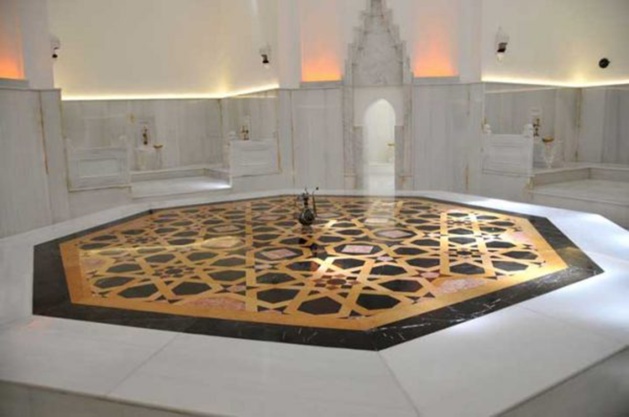 | Figure 1. Ornamentsin the Turkish bath. [9] |
3. Characteristic Spaces of Turkish Baths
- Bathe, defecate into contact with water has been one of the most basic needs of mankind through the centuries. This need is not important only in the physical sense, but also spiritual sense. However, once this cleansing action made in open areas have evolved; especially with the change of faith it has led to need for space. As a result, bath spaces that people can purify water by public or individual has emerged.Turkish bath or hammam is the name given to a facility for washing people made by heating the water. Hammam is a word of Arabic origin and its dictionary define is ‘heated place’, it is used for meaning ‘bathing place’ [8].The baths in Anatolia and Mesopotamia are the oldest baths in Turkey. The history of bath buildings started before Christ, after that these buildings appeared in Assyrian, Hittite, Ancient Greek, Rom and Turkish-Islamic societies with the best works [8]. Faith is the most important reason for the best works of bath buildings in Turkish-Islamic societies. In Islam, people cannot worship without cleaning their bodies with some rules, because of that, Islamic societies have to be in a relationship with water. That was the reason to built water structures, especially Turkish baths in those societies.It is specified that there are two reasons to built many bath buildings in Ottoman history. One of them, baths were the sources of income for some charity works like mosques, because they were good income generating business. The other reason is that baths served the mosque communities which are in the building complex that have Turkish bath and other buildings like hospital, school etc [8].Turkish bath buildings are not only the places to cleaning, also the places for many social uses. Because of that, they include tangible and intangible cultural heritage in the same time. In this sense, historical survey of intangible cultural heritage can be examined on the Turkish bath buildings.Turkish bath is affected from the baths before it and it is a kind of continuation of Rom baths in some ways. Rom baths are huge buildings had spread to the world’s many points and they have many monumental attributes, unique decor and figurations. Turkish baths are not huge and they have not monumental attributes as like Rom baths but they get some features from Rom baths [8].Turkish baths may be in palaces, mansions, inns or a large private property which is belong to a person or family and sometimes they are in bigger centres as like bazaars. In addition, there are some Turkish baths that named Public Bath, Arcade Bath or General Bath which are buildings of foundations for the people of villages, towns or cities and these bath buildings are single or double [15]. Gender and privacy have an important role to create single or double bath buildings. Double or single, all bath buildings have some parts which depend on the function and specifications. These parts are not always complete in different baths but in general, they can be listed as undressing (cold), lukewarm and heat parts. Additionally, there are cold and hot water tanks to provide water for bath and furnace [1].Bath buildings come into prominence in terms of cleaning as the spaces which are directly related to water. The high temperature which provides advanced physical cleaning is an important factor for spatial separation of bath buildings too. This spatial separation is about maintaining to the temperature and it is affected on the other activities except cleaning in the baths (Figure 2, 3).
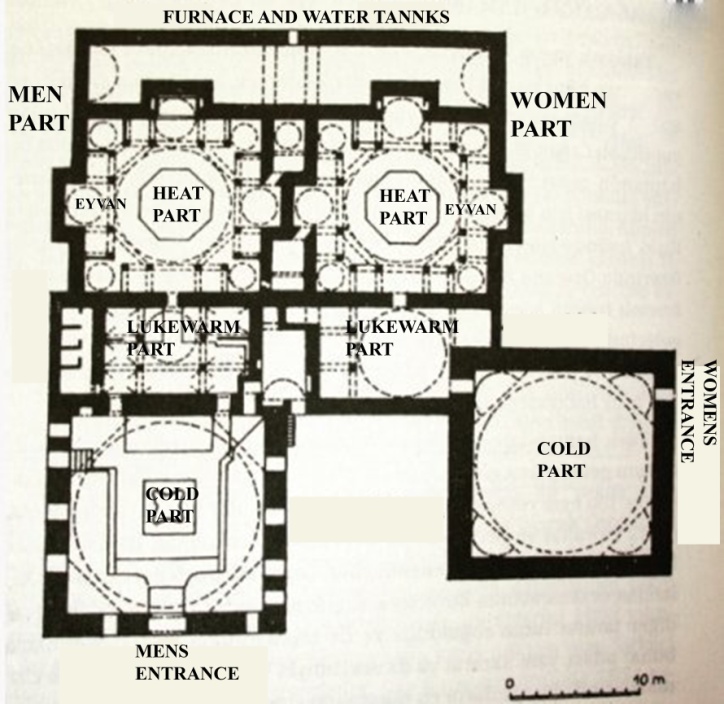 | Figure 2. Schematic Plan of Turkish Bath’s Spatial Layout in Classical Ottoman Period, Cağaloğlu Hammam Plan, Istanbul, Turkey [12] |
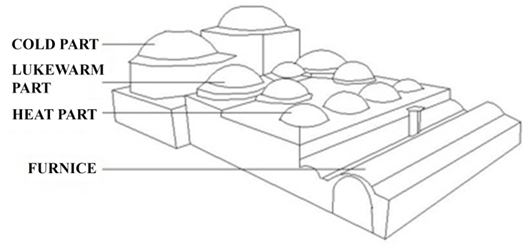 | Figure 3. Schematic Perspective of Turkish Bath’s Spatial Layout in Classical Ottoman Period [2] |
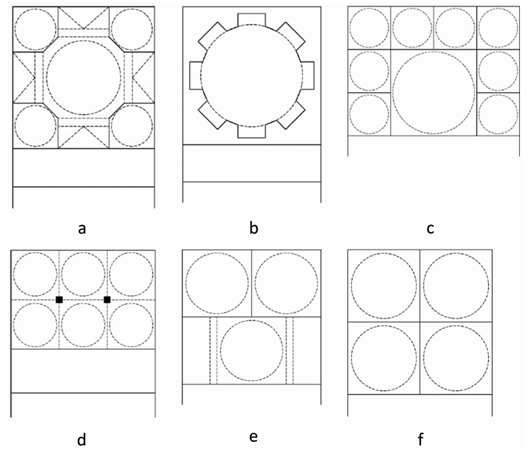 | Figure 4. Schematic Drawings of Turkish Bath’s Plan Typologies [6] |
4. Characteristic Social Uses in Turkish Bath Culture
- Turkish baths included not only cleaning and personal care activities, also some social uses too. Because they were places that people were together in it. In this sense, especially the faith system and living conditions of Ottoman Empire were effective. There are some rules for ladies in Islam; ladies can live only with their families and relatives, any foreign man cannot see a lady if she is not from his family or one of his friend. So, ladies were living in close places or open places only with their families. In this context, bath buildings were spaces that to be free and social for ladies (Figure 5).
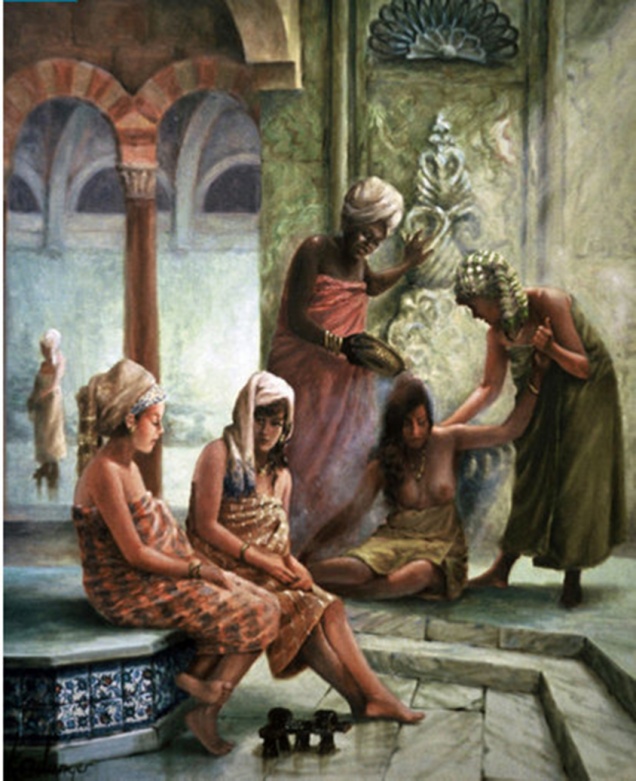 | Figure 5. Women who are bathing in the Turkish bath. [6] |
 | Figure 6. Classification of social uses in Ottoman Turkish bath culture |
4.1. Marriage Rituals
- Marriage has an important place in Ottoman culture as like many other cultures. In Ottoman culture that women and men cannot be together as comfortable in the same place in it, like a girl or boy for marriage was the task of the families; especially the task of mothers. In this sense, mothers were like a girl for their boys to marry in Turkish baths [16] (Figure 7).
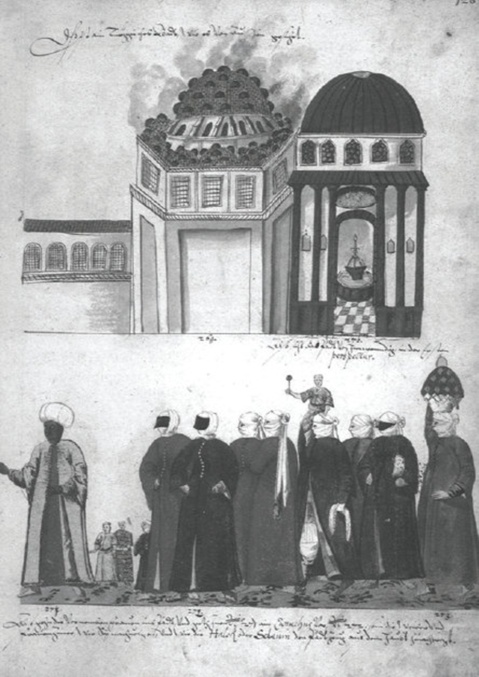 | Figure 7. Women who are going to the bath, Ottoman miniature, 16. Century (Vienna, Österreichische Nationalbibliothek) [19] |
4.2. Entertainment Activities
- In Ottoman Empire, men could enjoy together whenever they wanted but the women could not do that easily. Women’s entertainment places were more limited than men’s. In this context, Turkish baths were important socializing and entertainment places for women (Figure 8, 9). Many times there was no reason to enjoy together in a Turkish bath for women like feast or wedding party. In this sense, double baths’ women parts served women all the day and single baths served them at mornings generally. Women rent a Turkish bath for only entertainment and they started to the preparation of meals and drinks days ago [19]. In an addition, women prepared some packs called ‘bohça’ and they put towel, bath fiber, soap, scrub, scarf, henna, bath bowl and peştemal in bohça with mirror, comb, smut to titivate after the bathe. In another bohça, they put clean clothes and give all bohças to their maids to take it the bath before. When bohças were opened in the cold part of the bath, women's levels of wealth and status was revealed [3].
 | Figure 8. Le Barbier, Turkish Bath [7] |
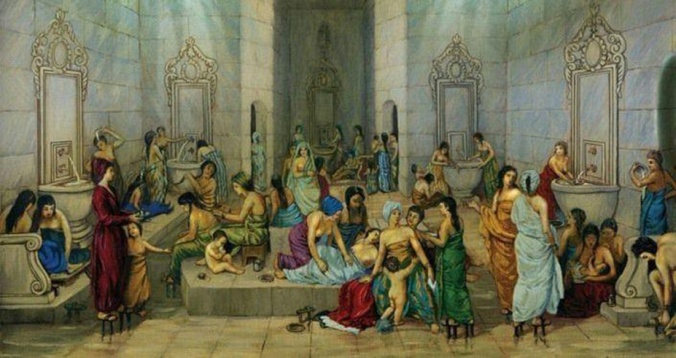 | Figure 9. Enderunlu Fazıl, Hubanname-Zennannâme, Hamam Session, 18. Century [7] |
 | Figure 10. Rogier, Women Bath, 19. Century [7] |
4.3. Religious Rituals
- The importance of physical purification and cleaning in Islam was quite effective on Turkish baths. Therefore, the relationship between religion and baths are a fairly tight and known relationship. Some beliefs that are specific to Islam religion have many important effects on Turkish baths‘ using ways.Feast days of Islam are important and enjoyable for Muslims. They enjoy in those days with some rules and pray with some rituals. In those feast days, cleaning is more important than other days’ routines. For instance, people wear new and unworn clothes and shoes in feast days. They want to purify their bodies before feast days and prays; so Turkish baths are more important before Islamic feast. Especially men use Turkish baths before feasts intensely and they purify their bodies in special bathing rooms of the heat part or on the navel stone together. The other religious ritual of Turkish bath is votive bath. In votive bath tradition which was common in Anatolia, votive holder that his or her wish realized rent a Turkish bath for 24 hours and invited all relatives, neighbours and friends with a candle or soap to celebration in the bath. In an addition, a man stood in front of the bath and he yelled to announced that there was votive bath in that day. Votive bath was open for everyone and votive holder offered meals and drinks to people in the bath. Also people believed that cleaning in a votive bath is a good deed in Islam, so everyone wanted to join it [3].In votive bath, cold part, lukewarm part and heat part of Turkish bath were used intensely because it was open for everyone. But it can be said that heat part was used more than others because it was the main bathe place of Turkish bath.
4.4. Activities for Health (Cure)
- Turkish baths were the best cleaning and purification places with high temperature and steam effects but in the same time, they were like a treatment centre for many different diseases. Some of Turkish baths were known a source of healing; because of that some people drank those baths’ water thinking that it was healing [4].Thorough cleaning of human body with some special soaps and bath fibers by special attendants of the baths called ‘tellak‘ rehabilitated some diseases and pains of the body [20].Turkish baths were not only the healing places for some diseases and pains, also for childless women too. The women were sat on hot pools of the heat part or near kurnas and these hot places that because of the heat system in the bath provided to women to renew their all bodies. They repeated this ritual repeatedly everyday till they had a child or giving up [3].In terms of health, especially the effectiveness of space heat was the most important reason of the importance of heat part and furnice with the heat system of Turkish bath.
4.5. Art Activities
- Turkish baths have many discussions and different chats because they were the places that different culture’s people was together and social in them. In those chats, there were art, literature, politics and poem topics too. Especially in winter months, famous poets came together in a Turkish bath and they chatted on many poems. In an addition, in the classical Turkish poetry, there was some special bath poets called ‘hammamiye‘ [18]. Important poets of Ottoman Fuzulî, Nabî, Nedim, Beliğ etc. issued Turkish baths in their poems [16].
5. Evaluation
- Architectural heritage is a versatile research area with tangible and intangible characteristics. In this context, intangible cultural value of architectural heritage is an important issue to investigate as like it’s structural, material and spatial aspects.As cultural heritages, Turkish baths have tangible and intengible values. Their tangible values are architectural and intangible values are socio-cultural. To evaluate these structures as multidirectional, their intangible cultural values should be examined as far as tangible values.Turkish baths are made up of a number of different features, both structurally and in terms of use, which stand out with their own characteristics. Especially in the context of social use, it is seen that the rituals performed in Turkish baths are only specific to this structure and are generally concentrated on religion, entertainment and health. With these rituals realized in it, Turkish baths;- Strengthening social relations and ensuring continuity,- Contributing to the development of new social relations,- In the societal context of the period, it is the people who create a field of freedom for both women and men,- And have become places where controlled public use is evident.The rituals, which have been an important part of social life, last a little. Nowadays, these rituals are applied in baths which serve the original function of touristic purposes or in alternate places.Although most of the Turkish baths have lost their original function, there are also baths that serve this purpose, even for touristic purposes. The continuing social use of these baths contributes to the integrated preservation of the tangible and intangible cultural heritage of these structures. Thus, continuing the values of intangible cultural heritage will contribute to the continuity of social memory.On the other hand, only a few of these rituals continue in different forms, in alternative spaces, by some social segments (upper income group). However, while the Turkish bath structures can be accommodated from every level of society in the period when these rituals take place, from individuals of all kinds; today, places that have similar rituals can only use individuals with a certain status.
6. Conclusions
- Bathing which has a rather long-established past, has an influential role in the formation of a characteristic space and mass fiction in Turkish baths. The resulting fiction also contributed to bath building to be a host for social rituals. In this context, entertainment, religious and health (cure) activities show that bath buildings are important spaces with social life in the Ottoman Empire term. Thus, more or less each place is related to different forms of social use in the baths.Today, social rituals in Turkish baths are getting weaker with the change of space and the loss of original function. Historically, the baths used by almost every segment of the society, now have been predominantly serving touristic purposes. However, the fact that the social rituals that are realized in Turkish baths, even for tourist purposes, are kept alive today will contribute to informing future generations about this issue and not to lose this important culture completely.This study showed that Turkish baths, as well as their original function, have become places where limitations brought by the social life of the period are overcome and social relations can be freely experienced. Thus they became an important part of the social life of the period they were actively used. Historical reading in the context of social uses in baths has been considered as an intangible cultural heritage in terms of today's conservation approach.As a result, it would be appropriate for the Turkish baths to be integrated protection in the social memory in the context of tangible cultural heritage in the spatial sense and in the context of intangible cultural heritage to its social use.
 Abstract
Abstract Reference
Reference Full-Text PDF
Full-Text PDF Full-text HTML
Full-text HTML